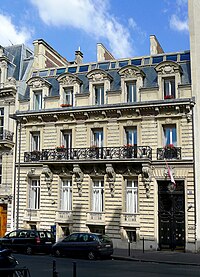World Organisation for Animal Health
This article needs additional citations for verification. (January 2017) |
show
World Organisation for Animal Health (OIE) | |
|---|---|
logo
| |
| Headquarters | Paris (International territory) |
| Official languages | |
| Membership | 182 member states[1] |
| Leaders | |
• President | |
• Director General | [2] |
• Vice president | Hugo Federico Idoyaga Benítez |
• Council |
|
| Establishment | |
• International agreement | 25 January 1924 |
Website www | |
The World Organisation for Animal Health, formerly the Office International des Epizooties (OIE) is an intergovernmental organization coordinating, supporting and promoting animal disease control.
Mission and status[]
The main objective of the OIE is to control epizootic[3] diseases and thus to prevent their spread.[4] Other objectives consist of: transparency, scientific information, international solidarity, sanitary safety, the promotion of Veterinary Services, food safety and animal welfare. It is recognized as a reference organisation by the World Trade Organization (WTO) and in 2018 had a total of 182 member states. Its newest member state is Saint Lucia.[5] The OIE maintains permanent relations with 45 other international and regional organisations and has Regional and sub-regional Offices on every continent. The OIE does not depend on the UN system; its autonomy is both institutional and financial and its activities are governed by its own constitutional texts. Since its first General Session held in Paris, the Office carries out its work under the authority of a Committee consisting of delegates of the contracting Governments.
History[]
The need to fight animal diseases at a global level led to the creation of the Office International des Epizooties through the international Agreement signed on January 25, 1924.
In May 2003, the Office became the World Organisation for Animal Health but kept its historical acronym OIE.[6]
In December 2016, 430 delegates to the 4th approved a range of measures aimed to improve animal welfare. An OIE strategy document which stemmed from this conference was to be presented for adoption at the OIE World Assembly in May 2017.[7]
In January 2017, the outgoing Obama administration designated the OIE as an organization entitled to benefits of the International Organizations Immunities Act.[8]
Headquarters[]

The OIE's headquarters are located in Paris, in the 17th arrondissement. It was in 1939 that the OIE moved to the aristocratic district of Parc Monceau, after having occupied premises since 1927 near the Champs de Mars and the Eiffel Tower, that had been provided by the French Higher Public Health Council. In May 1938, the OIE Members gave Dr Emmanuel Leclainche, founder and first General Director of the OIE, full powers to buy a townhouse in Paris, using the reserve fund. Dr Lecleinche chose the mansion from four properties selected by a Commission comprising the President of the OIE, H.C.L.E. Berger (Netherlands), the vice-president, Carlo Bisanti (Italy), and the accountant, Gotlieb Flückiger (Switzerland). On 22 February 1939, the OIE, represented by E. Leclainche bought the mansion from the Marquise de Montebello, at a cost of 700,000 francs. The 13th General Session of the OIE was held from May 30 to June 5, 1939, at 12 rue de Prony after rebuilding work had been completed. Due to the Second World War, the following General Session did not take place until 1946, from 2 to 5 October. Following their entry into Paris in June 1940, the German occupying forces temporarily closed and sealed the OIE headquarters. The efforts of the President, Gotlieb Flückiger, elected in 1939, resulted in its re-opening. 12 rue de Prony was built in 1879, in the Neo-Renaissance style, by the celebrated architect Jean-Louis Pascal for the Austrian Baron, Jonas Königswater, a former banker and railway owner. A succession of major works to renovate and modernise the headquarters were undertaken by the Directors General elected after E.Leclainche: Gaston Ramon, René Vittoz, Louis Blajan, Jean Blancou and Bernard Vallat. Due to the headlong development of the organisation (tripling of the staff and the budget since 2001), additional premises have been rented at 14 rue de Prony since 2004. On 16 March 2009, the OIE purchased a large part of the building at 14 rue de Prony, adjoining its headquarters.
World Animal Health Information Database (WAHID) interface[]
Timely dissemination of information is crucial to containing outbreaks. The WAHID Interface provides access to all data held within OIE's new World Animal Health Information System (WAHIS). It replaces and significantly extends the former web interface named Handistatus II System.
A comprehensive range of information is available from:
- Immediate notifications and follow-up reports submitted by Member Countries in response to exceptional disease events occurring in these countries as well as follow-up reports about these events,
- Six-monthly reports describing the OIE-listed disease situations in each country,
- Annual reports providing further background information on animal health, on laboratory and vaccine production facilities.
See also[]
References[]
- ^ Members Countries
- ^ "OIE gains new director general". American Veterinary Medical Association. 13 January 2016. Retrieved 22 January 2020.
- ^ Protect animals Pets
- ^ Missions of the OIE at OIE official website
- ^ "Opening of the 86th OIE General Session". World Organization for Animal Health. Retrieved 27 August 2018.
- ^ History of the OIE at OIE official website
- ^ "OIE welfare conference moves toward new global strategy". Informa Markets, a trading division of Informa PLC. Feedstuffs, a publication of FarmProgress.
- ^ "Executive Order -- Designating the World Organisation for Animal Health as a Public International Organization Entitled to Enjoy Certain Privileges, Exemptions, and Immunities". whitehouse.gov. 12 January 2017. Retrieved 20 January 2017 – via National Archives.
External links[]
| Wikimedia Commons has media related to World Organisation for Animal Health. |
- Medical and health organizations based in France
- Animal disease control
- Veterinary organizations
- Intergovernmental organizations
- Organizations based in Paris